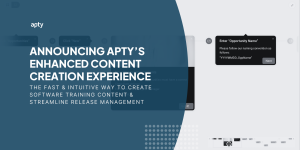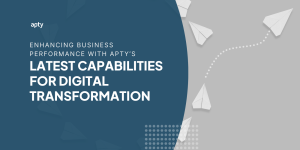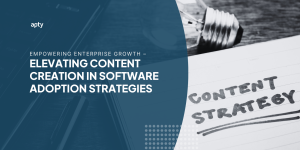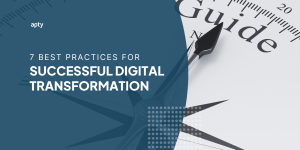With the advent of the digital era, every company is involved with digital technology in one way or another. IT leaders are taking center stage as organizations face a new digital reality. Creating a digital transformation roadmap becomes essential for embracing new technologies and reshaping business models and processes to ensure competitiveness and growth in the digital landscape.
Embracing Digital Transformation: Strategies for Success in the New Digital Age
In an era where digital reigns supreme, organizations increasingly recognize the imperative of digital transformation. For CIOs and transformation leaders, crafting a robust digital transformation roadmap isn’t just about adopting new technologies—it’s about reinventing business models and processes to drive sustainable growth and competitive advantage. This blog explains what a digital transformation roadmap entails, how to construct one, and highlights exemplary success stories equipped with data-backed insights and practical strategies to guide your journey.
With that comes new digital technologies and business models that can significantly change the business.
The efficacy of implementing such initiatives decides whether their impact is positive or negative. The ideal approach would be to create a digital enablement strategy and combine it with a Digital Transformation Roadmap. Doing so helps organizations navigate their Digital Transformation efforts.
In this detailed guide, we are going to cover:
- What is a Digital Transformation Roadmap?
- How to Build a Digital Enterprise Transformation Roadmap?
- Enterprise Technology Roadmap
- Top Digital Transformation Roadmap Examples
What is a Digital Transformation Roadmap?
At its core, a Digital Transformation Roadmap outlines the strategic steps organizations must take to harness digital technologies and meet their short-term and long-term objectives. Its blueprint starts with a comprehensive analysis of business needs, identifying gaps in current systems, and devising strategies to bridge these gaps efficiently.
The roadmap begins by understanding business needs and identifying gaps in the existing system, then building a strategy to fix these gaps.
Related Read: The Practical Guide for CIOs to Initiate Digital Transformation
Strengthening the Foundation with Data
A recent McKinsey study found that the average supply chain has a digitization level of 43 percent, the lowest of the five business areas that were examined[…]
The same McKinsey research suggests that, on average, companies that aggressively digitize their supply chains can expect to boost annual growth of earnings before interest and taxes by 3.2 percent—the largest increase from digitizing any business area—and annual revenue growth by 2.3 percent[…]
In our experience, most of the disparity between potential and actual gains from supply-chain digitization can be explained by technology gaps and management choices.
– McKinsey SCM Study
Relevant Read: Increasing Profit Margins: The Role of Digital Adoption in Supply Chain Management
If done incorrectly or inefficiently, “The average digital transformation stands a 45 percent chance of delivering less profit than expected.” (McKinsey)
Crunching the numbers on transformations suggests good news for companies that go broad, move fast and renew often, prioritize health, and keep stretching their aspirations[…]
The result: more than $60 million in bottom-line benefits, approximately 12 times more than the project the company had initially envisioned.
– McKinsey
According to a report by McKinsey, companies that aggressively digitize their operations can expect to boost revenue and enhance EBIT margins annually.
McKinsey’s analysis of over 200 large transformations reveals that the most successful efforts are characterized by their breadth and ambition, rapid execution and continuous renewal, strong focus on organizational health, and ever-evolving aspirations. These transformations are not limited to minor adjustments but entail an organization-wide commitment to enhancing both performance and the organization’s underlying health. By measuring and managing these aspects diligently, companies can significantly improve their chances of success.
For CIOs, this means going beyond adopting new technologies to encompass a broad scope that includes organizational culture, processes, and business models. It also highlights the necessity of moving quickly to capitalize on quick wins while maintaining momentum through continuous initiative renewal and adaptation. Moreover, prioritizing organizational health and setting ambitious goals are critical for sustaining long-term transformation success. Such a roadmap, informed by McKinsey’s research, ensures that digital transformation efforts are managed and strategically aligned with the organization’s long-term vision and health, setting the stage for a detailed exploration of each step in the transformation process.
How to Build a Digital Enterprise Transformation Roadmap?
The journey of digital transformation is marbled by challenges and opportunities alike. A well-defined strategy, patience, and persistent efforts are crucial to its success.
i. Assess the Current State
The aim is to assess the current business state by identifying favorable internal and external factors. Based on this, take action in areas where there are gaps or flaws.
Frameworks such as SWOT (Strengths, Weaknesses, Opportunities, Threats), STEEP (Social, Technological, Economic, Environmental, Political analysis), and STEEPLE (STEEP plus Legal and Ethical) are invaluable for this assessment. They provide a comprehensive view of internal capabilities and external factors.
SWOT
SWOT evaluates any business, project, or transformation efforts based on their Strengths, Weaknesses, Opportunities, and Threats. It helps identify the organization’s digital capabilities. Although it helps analyze both internal and external factors, it is predominantly used to identify internal capabilities.
STEEP
With STEEP analysis, you can measure political, social, economic, environmental, and technological factors. It goes beyond SWOT analysis and gives an in-depth understanding of the current state of your digital capabilities. STEEP is one of the best methods to analyze external factors.
STEEPLE
STEEPLE is similar to STEEP but with added capabilities. It considers legal and ethical factors, which help you identify cultural and compliance gaps within the organization. You can include these factors in your roadmap for digital transformation to improve the organization’s culture and digital capabilities. STEEPLE can be a bit tedious compared to STEEP and SWOT methods.
ii. Develop a Vision and Strategy
Now that you know all the possible gaps and flaws in the company, it is time to create a strategy that aligns with your business aspirations and goals. Once this part is sorted out, you can set an implementation plan.
While creating this plan, it is important to consider the latest Digital Transformation trends, as they will serve as a foundation for future initiatives, goals, and benchmarks.
Digital transformation is a top priority for 74 percent of organizations. Digital transformation is now prioritized over cybersecurity (73 percent) and cloud implementation (65 percent). 70 percent of companies either have a digital transformation strategy in place or are working on one.
– Kissflow
Relevant Read: Digital Transformation Statistics

Digital Roadmap Vision & Strategy Example
Let’s say you are a retail business with offline and online stores. You want to better understand customers and enhance their experience across all platforms. To achieve this, you must enhance your online capabilities to identify customers’ wants whenever they interact with your brand.
Think about your plan strategically with that goal in mind. You start investing in tools and resources that can map the user’s journey across all platforms and collect crucial data that tells more about their preferences and behavior (ex., a Digital Adoption Platform–DAP).
Based on this data, you can suggest better deals through online and offline stores, enhancing their experience with your brand. This way, you can achieve your goal of enhancing customer experience using digital means.
Vision: Transform customer experience across online and offline channels by deeply understanding customer needs and preferences, using digital tools to offer personalized services and promotions.
Strategy:
- Short-term (1-6 months): Deploy a Digital Adoption Platform (DAP) to collect data on customer interactions across all touchpoints and identify key behavior patterns and preferences.
- Mid-term (6 months-1 year): Utilize insights from DAP to personalize customer experiences, tailoring offers and communications online and in physical stores.
- Long-term (1+ years): Continuously refine customer experience based on ongoing data analysis, innovate the retail mix to anticipate future customer needs, and integrate next-gen technologies for seamless shopping experiences.
According to Gartner, 91% of businesses are involved in some form of digital initiative, and 87% of senior business leaders say digitalization is a priority. 89% of companies have already adopted a digital-first business strategy or plan to do so. This emphasizes the importance of a strategy-first approach that considers digital trends.
Leveraging digital trends is non-negotiable in this phase. For instance, integrating AI and ML for customer insights can significantly enhance customer experience across all touchpoints—a practice that retail businesses are moving towards, according to Statista and other market researchers.
In a 2023 survey carried out in the United States and the EMEA region, nearly 40 percent of retail directors stated they used artificial intelligence (AI), computer vision (CV), and machine vision (MV) for selected operations and departments.
– Statista
Current Digital Trend: According to a McKinsey Global Survey, the COVID-19 pandemic accelerated the digitalization of companies in all regions and sectors. Companies report increasing internal operations, customer, and supply-chain interactions by three to four years. The survey also found that the share of products in companies’ portfolios that are digitally enabled increased by seven years and that adoption rates are ahead of previous surveys.
iii. Start with Rewarding Projects
Initiate your digital transformation with projects that promise quick wins. This approach not only secures early ROI but also builds momentum for more complex initiatives.
Start the Digital Transformation journey with less complex projects that are easy to deploy, valuable, and financially viable for quick wins and social proof of change management processes. The idea is to get a return on your investments as soon as possible.

Waiting for all existing projects to be completed to get a final verdict on the success of your transformation initiatives wastes time. Each project has its own goal that makes it self-sufficient. If a minor goal is derailed, you can restart that project instead of the entire Digital Transformation initiative.
iv. Execute & Deliver in Phases
Implementing the digital transformation in phases allows for better project management, testing, and scaling. It’s advisable to have measurable tasks and objectives for each phase to track progress effectively.
Digital Transformation is a complicated process; deploying it in one refers back to point three and creates more complex projects. Enterprises focus on executing the transformation efforts phase-wise and testing the project in focus groups before scaling it up.
Divide the Digital Transformation plan into measurable tasks to get a more granular view of your initiative.
For each task, setting clear KPIs (Key Performance Indicators) and regular check-ins ensures that the project remains on track and adjustments can be made as needed. This granular approach allows for a more manageable and measurable path toward achieving the overarching digital transformation objectives, providing clarity and direction for all team members.

Let’s take a company that wants to provide a better customer experience, for example. Now, they can either go ahead and execute it as a whole or they can segment it into executable phases. In this case, they have segmented it into 4 phases.
Phase 1: Optimization of existing processes and automating the mundane tasks for better employee output.
Phase 2: Digitizing most of the new processes across all channels and platforms.
Phase 3: Integrating all digitized channels and processes together for better visibility and improved decision-making.
Phase 4: Ensuring the success of this digital ecosystem and new business models with successful learning and development programs.
Phase 1 ensures that repetitive tasks are automated to save employees time. Relevant existing processes are optimized for better outcomes. In the subsequent phases, the company digitized processes, integrated throughout the ecosystem, and ensured training for a better customer experience.
These phases can further be divided into “N” segments, but the number varies from business to business.
Let’s look at a more granular plan with placeholder benchmarks.
Example Plan – Digital Transformation Objective: Enhance Customer Experience Through a New Digital Platform
Phase 1: Planning and Assessment
- Task 1: Conduct a Current State Analysis
- Measure: Completion of a detailed report outlining current customer experience strengths, weaknesses, and technology gaps.
- Deadline: Month 1
- Task 2: Define Customer Experience Goals
- Measure: Establishment of clear, quantifiable objectives for the digital platform, including increased customer satisfaction scores by 20% within one year of launch.
- Deadline: Month 2
- Task 3: Perform Market and Technology Research
- Measure: Deliver a research report identifying leading digital technologies and competitor benchmarks.
- Deadline: Month 2
Phase 2: Design and Development
- Task 4: Select Technology Stack
- Measure: Selection of a technology stack based on scalability, security, and compatibility with existing systems, justified by a scoring matrix.
- Deadline: Month 3
- Task 5: Develop a Prototype
- Measure: Create and internally launch a functional prototype for initial feedback, with at least 80% stakeholder approval.
- Deadline: Month 4-5
- Task 6: Conduct User Testing
- Measure: Completion of user testing with at least 100 customers, aiming for a minimum 85% satisfaction rate regarding user interface and experience.
- Deadline: Month 6
Phase 3: Implementation and Rollout
- Task 7: Finalize and Deploy the Digital Platform
- Measure: Successful digital platform deployment, with system performance meeting pre-defined benchmarks (e.g., load time under 2 seconds).
- Deadline: Month 7-8
- Task 8: Train Staff on New Platform
- Measure: 100% of customer-facing staff trained on the new platform with a post-training test score average of 90% or above.
- Deadline: Month 9
Phase 4: Evaluation and Continuous Improvement
- Task 9: Collect Customer Feedback
- Measure: Gather feedback from at least 200 customers within the first month of launch to identify key areas for improvement.
- Deadline: Month 10
- Task 10: Implement Feedback and Optimize Platform
- Measure: Implement updates based on customer feedback, leading to a measured 15% increase in customer satisfaction scores.
- Deadline: Month 11-12
- Task 11: Continuous Monitoring and Optimization
- Measure: Establish ongoing analytics and monitoring for customer usage patterns, aiming for continuous monthly improvements in user engagement metrics.
How a Digital Adoption Platform Fits into a Digital Transformation Plan
Playing off the example above, a Digital Adoption Platform (DAP) can enhance the effectiveness of a digital transformation initiative to improve the customer experience of a new digital platform. By integrating a DAP, organizations significantly streamline the adoption process of the new technology for both employees and customers. Here’s how a DAP can benefit an organization in this context:
- Accelerated Learning Curve: A DAP provides in-app guidance and personalized support, helping users navigate the new digital platform efficiently. This reduces the learning curve and accelerates the adoption rate among users, ensuring that employees and customers can quickly become proficient with the new system.
- Increased Productivity and Engagement: A DAP minimizes frustration and downtime associated with learning new software by offering on-demand, contextual assistance. This leads to higher employee productivity and enhances customer engagement, contributing to a better overall experience with the digital platform.
- Real-time Analytics and Feedback: DAPs come equipped with analytics capabilities that allow CIOs and project managers to monitor usage patterns, identify bottlenecks, and gather feedback in real time. This data-driven approach enables continuous improvement of the digital platform, ensuring it evolves to effectively meet users’ needs.
- Support for Continuous Training: As the digital platform undergoes updates and enhancements, a DAP provides ongoing training and support to users. This ensures that all stakeholders remain up-to-date with the latest features and functionalities, facilitating seamless interaction with the platform over time.
- Cost Efficiency: Implementing a DAP reduces the need for extensive in-person training sessions and support calls. Organizations can lower training costs and decrease the burden on support teams by empowering users to self-serve their learning needs.
- Enhanced User Satisfaction: Ultimately, a DAP’s ease of adoption and continuous support lead to higher user satisfaction. For customers, this means a more enjoyable and frictionless experience with the digital platform, accompanied by reduced IT complaints, while employees benefit from reduced stress and increased confidence in using the new technology.
A DAP enhances the success of a digital transformation initiative by ensuring smooth adoption, offering real-time insights for ongoing optimization, and improving the overall experience for both employees and customers. By addressing common challenges associated with adopting new technologies, a DAP directly contributes to achieving the overarching goal of improved customer experience through digital transformation.
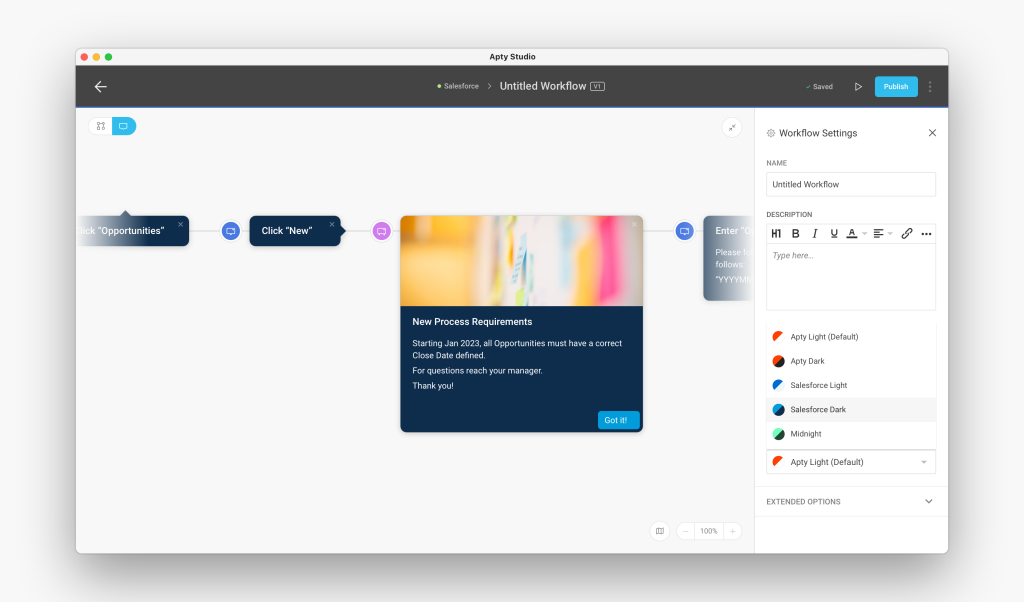
Want to learn more about a Digital Adoption Platform?
Schedule a demo with one of our Digital Transformation & Adoption Experts.
v. Digital Agility: Build Capabilities Continuously
Modernizing core operating infrastructure and processes helps organizations enhance their digital experience for customers and employees.
Harvard Business Review reports a widening workplace divide with a shortage of workers with digital and data science skills. Learning and Development teams, Human Resources, and Software Admins face tougher onboarding and training initiatives during endless digital initiatives. With IT teams tasked to implement these updates and Change Leaders expected to show value from these digital transformation initiatives, all departments are turning to digital adoption platforms to build digitally agile tech stacks with seamless onboarding.
Introducing new infrastructure necessitates hiring fresh talent and upskilling current employees. It’s crucial for IT and business leaders to collaborate on developing a unified training program that supports their digital transformation goals.
One-time training and expertise provided by veteran employees will not provide any real value to your business once you start scaling your organization. Even with years of experience, most employees find it hard to navigate new software. This is why providing continuous training is crucial.
Business leaders need to address two types of skills required for success: job-related and application-oriented.
Training methods will need to adapt, possibly through hiring for specific job skills or launching online programs for current staff. Yet, this approach falls short for application-related skills.
Training employees on any application should be an ongoing process, and tools like a learning management system (LMS) and digital adoption platform can help.
Enterprise Technology Roadmap Best Practices
Organizations should invest in valuable technologies, and digital leaders need to spot trends that help manage disruptions and meet business objectives.
Enterprise technology roadmaps lay out the plan for tech adoption and upgrades, but it’s key to stick to this plan to avoid scope creep, where projects expand beyond their original boundaries, causing delays and budget overruns.
Seventy-five percent of companies ran over the cloud migration budget, 18% were on the plan, and just 7% managed to spend less than forecasted.
– Dev.pro
By integrating a Digital Adoption Platform (DAP) into their technology implementation or change management plans, enterprises can prevent scope creep by providing real-time guidance and support. This ensures users quickly adapt to new systems without expanding project boundaries. This focused approach keeps the project on track and within the original specifications.
A. Revamp the Tech Stack
Enterprises often use outdated technology, making it hard to adopt new technology without affecting their finances and operations. Old technology slows down response to changes, risking the loss of customers and employees. Businesses need to identify which technologies limit their flexibility and return on investment (ROI) and invest in ones that help them quickly adapt to customer needs.
Modernizing your technology stack is crucial for flexibility and ROI. The shift to cloud computing, for instance, offers scalability and cost-efficiency,
According to a RapidScale report, 94% of businesses noted an improvement in security after moving to the cloud, and 91% said the cloud made it easier to meet government compliance requirements.
– Forbes
Revamp software roadmaps can steer organizations away from costly rip-and-replace implementations by tackling the underlying issue of software adoption. Often, the problem isn’t the technology itself but how well it’s being used. By focusing on improving digital adoption, organizations can enhance the value of existing technologies without the need for extensive overhauls.
- Implement Digital Adoption Platforms (DAPs): DAPs guide users through new and existing software, improving utilization and efficiency.
- Conduct Training and Support: Tailored training programs address specific adoption barriers, ensuring employees can fully leverage the technology.
- Monitor Usage and Feedback: Regularly analyzing software usage and gathering user feedback can highlight areas for improvement.
- Iterative Improvements: Make continuous, small adjustments based on real usage data and feedback instead of major overhauls.
A CIO can leverage Apty‘s analytics to assess the health of their organization’s tech stack, pinpointing areas that need revamping to improve user experience (UX), user interface (UI), training, onboarding, compliance, and overall digital experiences. By analyzing usage patterns and user feedback, a CIO can make informed decisions to enhance the effectiveness and efficiency of their technology investments.
- Identify UX/UI Improvements: Use analytics to spot where users struggle or disengage, indicating potential UX/UI enhancements.
- Enhance Training Programs: Determine which features or processes users find confusing and tailor training to address these gaps.
- Streamline Onboarding: Identify common stumbling blocks for new users to simplify the onboarding process.
- Ensure Compliance: Monitor how well users adopt and understand compliance-related features.
- Optimize Digital Experiences: Analyze user interaction data to continuously refine and improve digital touchpoints and business processes executed through your applications.
B. Adopting New Technologies
After selecting the necessary technology, it’s critical to plan the implementation phase and prioritize the strategy for adoption from the start. Overlooking this step can risk the success of new technology investments and potentially disrupt overall transformation efforts. The effectiveness of technology hinges on its users; hence, involving them early in the implementation phase to understand their concerns and gather feedback is crucial. This collaboration will inform the development of a tailored adoption strategy, facilitating a smoother transition for employees and customers alike.
Unlike common misconceptions, training and adoption are not synonymous. Training focuses on enhancing individual skills and performance, while adoption aims at maximizing technology usage across the organization.
Therefore, leaders should develop a digital adoption strategy supported by a Digital Adoption Platform (DAP) to stay competitive and empower their workforce, whether remote, hybrid, or in-office. A DAP provides insights into user interactions with the new technology, enabling the creation of user-specific guidance. This approach simplifies navigation through complex applications and allows for real-time monitoring of adoption rates. If adoption risks are detected, the organization can proactively engage users with customized alerts and step-by-step walkthroughs, ensuring comprehensive support and enhancing the success of technology adoption.
Digital Adoption Platform content will guide users through your applications and across tech stacks for an integrated and engaging digital experience. This helps achieve productivity goals and accomplish tasks faster through self-help methods. Irrespective of the complexities of the application, a digital adoption platform will ensure that the user navigation is smooth.
Moreover, the organization can track whether application adoption is at risk. If it is, it can send a customized alert message within the application to specific users, enforcing, changing, or adapting user behavior to comply with appropriate processes, reporting, and compliance standards.
These DAP alerts, or notifications, will inform users about the importance of completing a task, report, timesheet, or process. The walkthroughs integrated into and launched from these notifications will guide employees through the aforementioned workflow until completion.
C. Future-proofing Your Digital Transformation Roadmap
While developing a roadmap to outpace competitors is beneficial, it’s crucial to assess whether it meets the future needs of your employees and customers. If it falls short, it may not be the correct strategy. Leaders should incorporate foresight into their technology implementations, considering the long-term implications. Starting a new initiative can be time-consuming and requires approval from various stakeholders, making it essential to have a forward-looking vision. This approach ensures your organization is prepared and resilient against market disruptions, securing a competitive advantage in the evolving business landscape.
When planning for the future, here are some short and long-term implications to consider:
Short-term Implications:
- User Adoption Rates: Quick adoption of new technology by employees and customers can drive immediate benefits.
- Initial Costs: Upfront investment in technology and training may impact the budget.
- Operational Disruptions: Temporary disruptions to workflows during the transition phase.
Long-term Implications:
- Scalability: Whether the technology can grow with your business needs over time.
- Maintenance and Support: Ongoing costs and resources required to maintain and update the technology.
- Market Evolution: How changes in market demands and technology trends may affect the relevance and effectiveness of the implemented solutions.
- Data Security and Compliance: Ensuring the technology remains secure and compliant with evolving regulations and standards.
- Workforce Skills: The need for continuous learning and development programs to keep skills aligned with technological advancements.
Summary: Digital Transformation Roadmap for CIOs
Creating a digital roadmap as a CIO involves a strategic plan that not only meets current organizational needs but also anticipates future trends and challenges. Here’s a succinct, action-oriented roadmap:
- Assess Current Technology Stack:
- Identify outdated technologies and processes.
- Benchmark against industry standards to understand where you stand.
- Define Clear Objectives:
- Align technology goals with business outcomes.
- Focus on enhancing customer experience and operational efficiency.
- Prioritize User Adoption:
- Implement Digital Adoption Platforms (DAPs) to facilitate smooth transitions to new technologies.
- Measure initial user adoption rates and aim for continuous improvement.
- Invest in Training and Support:
- Develop tailored training programs for different user groups.
- Monitor engagement and feedback to adjust training materials as needed.
- Incorporate Data Analytics:
- Utilize analytics to track technology usage and identify areas for optimization.
- Set benchmarks for user engagement and system performance, aiming for industry-leading standards.
- Future-Proof Your Tech Stack:
- Evaluate new technologies for scalability and adaptability to future needs.
- Stay informed on emerging trends that could impact your industry.
- Ensure Continuous Improvement:
- Regularly review and update your technology roadmap based on performance data and market changes.
- Encourage a culture of innovation that supports ongoing learning and adaptation.
By following this roadmap, a CIO can lead their organization through a successful digital transformation, ensuring that technology investments deliver value now and remain agile for future developments. Keeping an eye on industry benchmarks and continuously engaging with internal stakeholders and customers will ensure your technology strategy stays aligned with evolving business goals.
Top Digital Transformation Roadmap Examples

UPS Digital Transformation Use Case
UPS (United Parcel Service) is a leading American supply chain management company. It leveraged digital technologies to streamline its supply chain strategy to meet the growing and changing demands of the customers.
UPS could not track the real-time packages, and delivery was relatively slow compared to its peers.
They decided to use technologies like Big Data, AI, and ML. Keeping these technologies at the heart of their digital transformation initiatives, they created an application called ORION, which stands for On-road Integrated Optimization and Navigation.
The machine-learning algorithm of this application started recommending the optimal routes for delivery. It considered the routes’ past performance and the current scenario before giving recommendations to the drivers.
This not only helped the company deliver at a faster rate but also saved them over $50 million, as they reduced their fuel consumption by 10 million gallons.
Then, they invested in network planning tools that helped them track package flow and eliminate bottlenecks in real time. These tools also enabled them to combine shipments for multiple consignments, which helped them save millions of dollars on operational costs and meet customer expectations.
Case Study: Salesforce CRM Implementation Success at Mary Kay

Mary Kay’s decision to implement Salesforce as its enterprise CRM application marks a significant step in its digital transformation journey. This strategic initiative aimed to revolutionize customer relationship management, sales processes, and data analytics, leveraging Salesforce’s advanced capabilities to enhance business outcomes.
- Enhanced Customer Relationship Management: By adopting Salesforce, Mary Kay achieved a 360-degree view of its customers, allowing for personalized communication and service. This comprehensive understanding of customer preferences and behaviors enabled Mary Kay to tailor its marketing strategies more effectively, leading to increased customer satisfaction and loyalty.
- Streamlined Sales Processes: Salesforce’s CRM system provided Mary Kay’s sales force with powerful tools to manage their sales activities more efficiently. Features such as lead and opportunity management, sales forecasting, and performance analytics helped streamline the sales process, reduce the sales cycle, and improve conversion rates.
- Improved Data Analytics and Reporting: With Salesforce, Mary Kay gained access to real-time data analytics and customizable reporting tools. This capability allowed for more informed decision-making, helping the company to identify trends, measure performance against goals, and adjust strategies as needed.
- Digital Adoption Platform (DAP) Role: The integration of a Digital Adoption Platform played a critical role in successfully adopting Salesforce at Mary Kay. The DAP facilitated onboarding and continuous learning for employees, ensuring they could fully leverage the CRM system’s capabilities. Interactive guides, contextual help, and task automation provided by the DAP helped overcome any learning curves associated with the new software, ensuring high user engagement and productivity.
- Maximizing ROI: The successful implementation of Salesforce CRM, supported by a robust digital adoption strategy, enabled Mary Kay to maximize its return on investment. The enhanced customer insights, streamlined sales processes, and data-driven decision-making capabilities resulted in higher sales, better customer retention rates, and overall business growth.
This case study highlights how embracing a leading CRM solution like Salesforce and strategically using a Digital Adoption Platform can transform customer relationship management and sales operations, driving significant business value and competitive advantage.
Hershey’s Failed ERP Implementation Use Case

The Hershey Company had to pause significant parts of its ERP project, including supply chain enhancements, due to the COVID-19 pandemic, shifting focus to immediate business needs. Despite this setback, certain aspects of the ERP implementation, such as finance and data management aimed at gaining real-time customer insights, continued. The pandemic’s impact forced Hershey’s to adjust its manufacturing and shipping to align with changing consumer behaviors, including a shift towards online sales and away from instant consumables.
How a DAP like Apty could have helped:
- Facilitate Remote Training and Onboarding: With the shift to remote work, Apty could provide virtual, on-demand training and support for employees adapting to the new ERP system, ensuring uninterrupted learning despite the pandemic.
- Adapt Quickly to Changing Priorities: Apty’s flexibility could help Hershey’s rapidly adjust its ERP training and adoption strategies to focus on critical areas like finance and data management, even as other parts of the project were paused.
- Enhance User Engagement: By offering personalized guidance and support, Apty could maintain high user engagement and ensure that the ERP system’s adoption doesn’t stall due to the pandemic-induced changes in working conditions.
- Provide Real-time Analytics: Apty’s analytics capabilities could offer Hershey insights into how employees use the ERP system remotely, identifying areas where users struggle and need additional support, thus optimizing the ongoing implementation efforts.
- Support Change Management: Apty could assist Hershey’s in managing the change more effectively, helping employees navigate the new system’s functionalities and ensuring continuity in operations and training amidst the pandemic’s disruptions.
An older Hershey’s implementation use case occurred similarly back in 2010.
Hershey’s ambitious ERP project faced significant challenges due to aggressive scheduling and inadequate testing, leading to a failure that resulted in a 19% drop in quarterly profits and an 8% decline in stock price. The project aimed to integrate SAP’s R/3 ERP, Manugistics’ supply chain management, and Siebel’s CRM software within a condensed 30-month timeline to be Y2K compliant. However, launching during Hershey’s peak season without thorough testing prevented processing $100 million worth of orders.
How a DAP like Apty could have helped:
- Enhanced Training and Onboarding: Apty could have provided targeted training and support, ensuring Hershey’s employees were well-prepared to navigate the new ERP system, even during peak seasons.
- Accelerated Adoption: By guiding users through real-time, on-screen instructions, Apty could have accelerated the adoption of the new systems, mitigating the steep learning curve associated with ERP implementations.
- Improved Testing Scenarios: Apty could offer analytics and insights into user behavior and system interaction, helping to identify potential issues in realistic testing environments before full rollout.
- Support for Incremental Rollouts: Leveraging a DAP like Apty for targeted departments or processes could have supported a more phased implementation approach, reducing the risk associated with a “big bang” launch.
- Monitoring and Feedback for Continuous Improvement: Continuous monitoring of user engagement and feedback within Apty could have identified and addressed areas of concern in real-time, preventing operational paralysis.
By addressing key factors such as adequate systems testing, realistic project scheduling, and comprehensive user training and support, Hershey’s could have significantly reduced its exposure to failure risks. Implementing a digital adoption platform like Apty as part of the ERP project could have played a critical role in successfully navigating these challenges.
What’s Next?
While digital transformation offers a pathway to revolutionize business operations, its success relies on continuous adaptation, strategic planning, and embracing innovation. Remember, there’s no one-size-fits-all formula; each organization must navigate its own journey, drawing on the insights and strategies discussed here.
The journey of digital transformation is complex yet rewarding. By learning from and embedding data-backed insights, research findings, and real-world use cases into your digital transformation strategy, you can provide substantive value to CIOs and transformation leaders.
T projects may face delays, process gaps, insufficient training, and emerging regulatory challenges. However, with appropriate tools and strategies, these issues can be addressed effectively, without a one-size-fits-all solution. Companies must adapt and refine their strategies as projects evolve.
Digital Adoption Platforms (DAPs) offer valuable support in pinpointing process deficiencies, enhancing training quality, supplying on-demand training materials, and assisting employees in their daily tasks.


